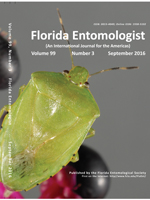We report a likely range expansion of the introduced social wasp Polistes major major Palisot de Beauvois (Hymenoptera: Vespidae) from Florida into southern Georgia, USA, as well as the first records of Polistes apachus de Saussure from Georgia. We also review what is known of the history of these species in the southeastern United States.
Social wasps present some of the most problematic invasive species worldwide (Beggs et al. 2011). Polistes is a large, cosmopolitan genus of eusocial wasps, and like other social vespids, its members can create environmental problems when introduced to novel environments. Here, we report 2 new distributional records for the introduced social wasps Polistes major major Palisot de Beauvois and Polistes apachus de Saussure (Hymenoptera: Vespidae), in the state of Georgia, USA.
We first encountered P. major major on 7 Apr 2014 at the Altamaha Wildlife Management Area just south of Darien, Georgia, in McIntosh County (31.3507667°N, 81.4465222°W). Five female foundresses were observed on 4 pre-emergence colonies (Fig. 1). Nests were located on several wooden structures adjacent to a series of freshwater marsh impoundments. Additional colonies were sought but not found on buildings surrounding the docks in Darien, as well as buildings near similar habitat in Harris Neck National Wildlife Refuge and Fort McAllister State Park. On 29 May 2014, another nest with a single foundress was observed on a building at the docks in St. Marys, Georgia (Camden County). In early May 2015, 2 colonies were observed on the same structures at the Altamaha WMA, though both were destroyed by predators before worker emergence. Given the number of colonies seen and the persistence of this species across years, it seems likely that P. major major is now established, at least locally, in coastal Georgia.
We sought other records of this species in the region by examining collections at the American Museum of Natural History, the University of Georgia Collection of Arthropods, and the collection at Georgia Southern University. We found no specimens from Georgia in any of these collections, and none exist in the Florida State Collection of Arthropods (Kevin Williams, personal communication). Consulting BugGuide.net, an online repository of insect photos, we found 1 voucher photograph of P. major major from Ware County in southern Georgia from 2008.
Figs. 1 and 2.
Polistes major major in Georgia and Florida. 1. An incipient colony in McIntosh County, Georgia. 2. Distribution of P. major major in Georgia and Florida. Counties with reports of this species are grey, and years represent the earliest observation in that county. Data were collected from museum collections and BugGuide.net (see main text).

Polistes major major ranges from Arizona and Texas south to Brazil and is present in Cuba, Hispaniola, Puerto Rico, and The Bahamas (Richards 1978). The first record of it in Florida in the collections we examined is a specimen from 1975 collected in Palm Beach County. The first published record of P. major in Florida dates from 1958 (Krombein et al. 1958); earlier synopses of Polistes do not include Florida in its range (Bequaert 1940; Muesebeck et al. 1951). Thus, it seems likely that this species was introduced in southern Florida prior to 1958 and has spread northward, apparently as far as central coastal Georgia. Based on collection and BugGuide.net data, as shown in Fig. 2, the earliest observations are from southern Florida counties and later in north Florida and Georgia, though it is not clear whether collecting efforts in these areas were substantial enough for this to imply a recent arrival in Georgia. When the expansion northward into Georgia occurred is unknown, but it seems valuable to monitor for changes in the northern limits of this species' range as expansion may be ongoing.
While examining the Georgia Southern University collection, we encountered 2 specimens of P. apachus: a male collected in northern Georgia (Acworth, Cobb County) on 9 Apr 2011 and a female collected in southern Georgia (Statesboro, Bulloch County) on 17 Nov 2011. This species is known from Florida, Texas, Utah, Arizona, Colorado, New Mexico, Oklahoma, Kansas, and strays into southern Iowa (Bequaert 1940; Richards 1978; Krombein et al. 1979). It was also introduced into California, where it is an agricultural pest (Krombein et al. 1979). These specimens suggest P. apachus may occur in Georgia, though they could be vagrant individuals rather than members of an established population.
Given the abundance and diversity of native paper wasps in this region, the adverse ecological effects of these alien species may be minimal. However, introduced species can bring with them novel pathogens that could harm native and agricultural insect populations, and an expanded range may increase the chances of introduction elsewhere in the world where ecological effects may be more severe. Polistes major major seems prone to human-mediated expansions, given the introduction into the southeastern U.S. and the recently reported adventive population in Spain, the first alien Polistes in Europe (Castro et al. 2013). Monitoring the distribution of such species may be helpful in understanding the dynamics of species invasions.
We thank Kevin Williams for sending us information on specimens in the Florida State Arthropod Collection, and Rick Hoebeke and Lance Durden for welcoming us to the University of Georgia Collection of Arthropods and the Georgia Southern University Entomology Collection, respectively.





